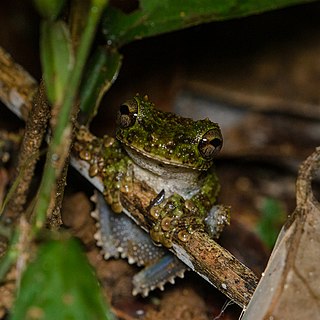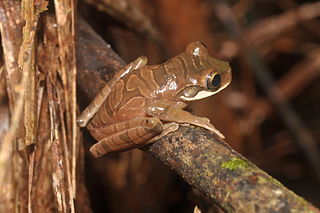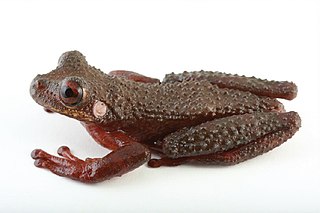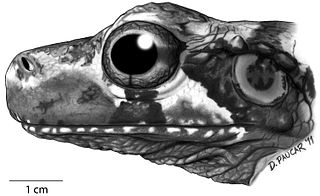
Osteocephalus is a genus of frogs, the slender-legged tree frogs, in the family Hylidae found in the Guianas, the Amazon Basin, Venezuela, Colombia, southeastern Brazil, and north-eastern Argentina. Males are warty, while females are smooth.
Hyloxalus bocagei is a species of frog in the family Dendrobatidae. It is found on the northeastern side of the Andes in Ecuador and in Colombia. The specific name bocagei honors José Vicente Barbosa du Bocage, a Portuguese zoologist. Common name Bocage's rocket frog has been coined for this species.

Dendropsophus marmoratus is a species of frog in the family Hylidae. It is found in the Amazon rainforest and montane forests in the eastern piedmont, in Bolivia, Brazil, Colombia, Ecuador, French Guiana, Guyana, Peru, Suriname, and Venezuela. Its natural habitats are subtropical or tropical moist lowland forests, intermittent freshwater marshes, and heavily degraded former forest. "Marmoratus" in Latin means "marble," perhaps referring to the dorsal coloring pattern. It is threatened by habitat loss.

Osteocephalus helenae is a species of frog in the family Hylidae. It is widely distributed in the Amazon Basin and is known from the lowlands of Bolivia, Peru, Brazil, Colombia, Venezuela, Guyana, and French Guiana. The specific name helenae honors Helen Beulah Thompson Gaige, an American herpetologist. Common name Helena's [sic] treefrog has been proposed for it.

Osteocephalus buckleyi, also known as Buckley's slender-legged treefrog, is a species of frog in the family Hylidae. It is found along the periphery of the Amazon Basin in Bolivia, Peru, Ecuador, Colombia, northeastern Brazil, Venezuela, Guyana, Suriname, and French Guiana, and also in the Orinoco Delta in Venezuela. It is probably a species complex. Some sources treat Osteocephalus vilmae from Ecuador and Peru as a valid species.

Osteocephalus cabrerai is a species of frog in the family Hylidae. It is found in the Amazon Basin in Brazil (Manaus), northeastern Peru, Ecuador, Colombia, Guyana, and French Guiana, possibly wider. Some earlier records refer to Osteocephalus buckleyi.
Osteocephalus deridens is a species of frog in the family Hylidae. It is found in the Napo and Pastaza River drainages in eastern Ecuador and in the Loreto Region, northern Peru. The specific name deridens is derived from Latin deridere, meaning "make fun of someone". This alludes to the males calling from the treetops that sound "as if they are laughing at the collectors' vain attempts to reach them". Common name funny slender-legged treefrog has been coined for this species.
Osteocephalus fuscifacies is a species of frog in the family Hylidae endemic to Ecuador. It is known from the Napo River drainage at intermediate elevations. The specific name fuscifacies is derived from Latin fuscus (=tan) and facies (=face), in reference to the uniform tan-colored loreal region and the lack of a light subocular spot. Common name Napo slender-legged treefrog has been coined for this species.

Osteocephalus mutabor is a species of frogs in the family Hylidae found on the western Andean foothills of Ecuador and south to Ucayali Region of Peru. Before Osteocephalus mutabor was described as a new species in 2002, it was confused with Osteocephalus leprieurii.

The Manaus slender-legged tree frog, also known as the giant broad-headed tree frog, is a species of frog in the family Hylidae found in Bolivia, Brazil, Colombia, Ecuador, French Guiana, Guyana, Peru, Suriname, and Venezuela. Its natural habitats are subtropical or tropical dry forest, subtropical or tropical moist lowland forest, moist savanna, rivers, intermittent freshwater marshes, and canals and ditches. It is threatened by habitat loss. It is also reported to produce Bufotenin.

The Ecuador slender-legged tree frog is a species of frog in the family Hylidae found in Colombia and Ecuador. Its natural habitats are subtropical or tropical moist lowland forests, subtropical or tropical moist montane forests, rivers, intermittent freshwater marshes, rural gardens, and heavily degraded former forests.

Scinax ruber is a species of frog in the family Hylidae which is known in English as the red snouted treefrog or red-snouted treefrog, sometimes also Allen's snouted treefrog, the latter referring to the now-synonymized Scinax alleni. This widespread species is found in much of Amazonian and northern coastal South America and into Panama, as well as in some Caribbean islands as introduced populations. It is a complex containing several cryptic species.
Pristimantis croceoinguinis is a species of frog in the family Strabomantidae. It is found in the lowland Amazon rainforest of southern Colombia, eastern Ecuador, and extreme north-eastern Peru, likely also extending into the adjacent Brazil. The specific name croceoinguinis refers to the color of the inguinal spots of this frog. Common name Santa Cecilia robber frog has been proposed for it.
Niceforonia dolops is a species of frog in the family Strabomantidae. It is found in the Andes of southern Colombia and northern Ecuador. Specifically, it is known from the Cordillera Oriental and Colombian Massif in Caquetá and Putumayo Departments, Colombia, and Napo Province, Ecuador. Common name Putumayo robber frog has been coined for it.

Diasporus gularis, also known as the Esmeraldas robber frog, is a species of frog in the family Eleutherodactylidae. It is found in western Colombia and northwestern and central Ecuador.
Pristimantis pseudoacuminatus, also known as Sarayacu robber frog, is a species of frog in the family Strabomantidae. It is found in the Amazon basin in Colombia, Ecuador, and Peru.

Pristimantis pycnodermis, also known as thickskin robber frog, is a species of frog in the family Strabomantidae. It is endemic to the Ecuadorean Andes and occurs in the Cordillera de Matanga in the Azuay and Morona-Santiago Provinces. The specific name pycnodermis is Greek and means "thick skin", a characteristic of this species.
Pristimantis serendipitus is a species of frog in the family Strabomantidae. It is found in the Andes of northern Peru and adjacent southern Ecuador. The specific name refers to serendipitous discovery of this species: collection at the type locality was only made because the road was closed by an accident. Common name Colan Mountains robber frog has been proposed for this species.

Pristimantis unistrigatus, common name: striped robber frog, is a species of frog in the family Strabomantidae. It is found in the Andean valleys from southern Colombia to central Ecuador.

Osteocephalus cannatellai is a frog in the family Hylidae endemic to Ecuador and Colombia. Scientists have seen it between 200 and 1290 meters above sea level.













